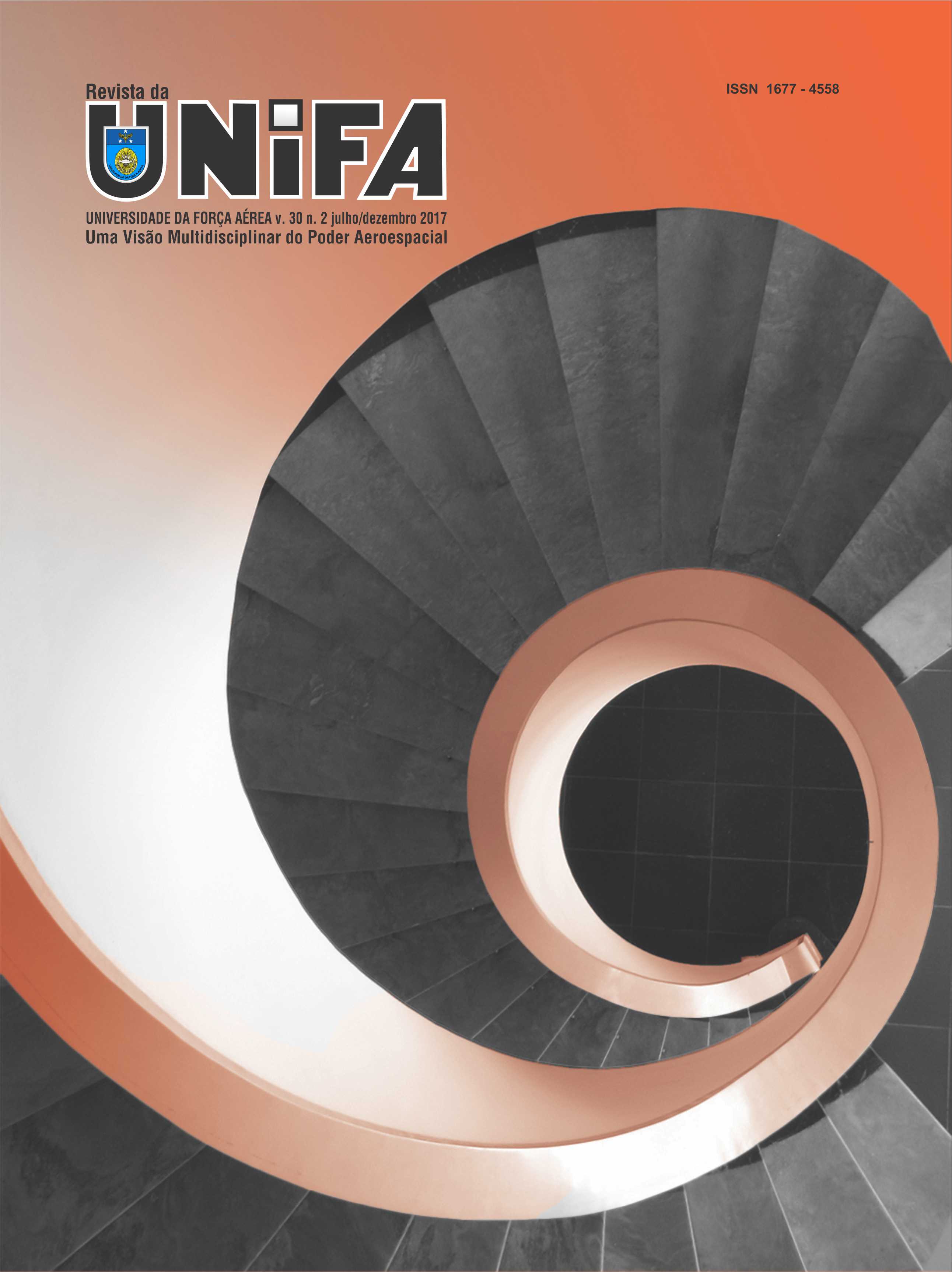Level of schooling and its impact on the training course of 64 Infantry Battalion soldiers
DOI:
https://doi.org/10.22480/revunifa.2017.30.488Keywords:
Training course for soldiers, Level of schooling, Performance, Theory of meaningful learningAbstract
The new Strategic Plan for Air Force 100 is a broad process of restructuring of Aeronautical Command (COMAER). Among the areas of action, the refinement of human resources management is highlighted, with emphasis in the fields of recruitment, selection and training. Immersed in this triad, the aim of this study was to verify the influence of soldiers’ level of schooling during the recruitment stage on the degree of performance obtained at the end of the Soldiers Training Course (CFSd) of 2015 and 2016 teams of the 64 Infantry Battalion (BINFA-64). Directing the discussion, the Theory of Meaningful Learning (TAS) was chosen, which interprets the construction of the individual’s cognitive structure and emphasizes that knowledge preexisting in learners’ mental framework acts as an anchor of knowledge (Subsumption), serving as a support to formation of new knowledge. The Mapping of the research objective was established in two aspects. In the foreground, basing and validating the schooling level records of the 421 soldiers under study was sought at the time of the incorporation. It was verified that the military had complete elementary school degree (3%), incomplete secondary school degree (17%), complete secondary school degree (66%), complete secondary school degree (10%) and incomplete higher education degree (4%). Under another perspective, the research focused on recording the soldiers’ final performance score at the end of the course. School and performance data collected were statistically compared using the Pearson coefficient. The value of 0.85, tested by the coefficient, indicated a strong correlation among the variables. Associated with TAS precepts, from this result it was concluded that the highest performance scores corresponded to the highest school levels.
References
AUSUBEL, D. P. Aquisição e retenção de conhecimentos: uma perspectiva cognitiva. Lisboa: Paralelo, 2003.
BRASIL. Comando da Aeronáutica. Departamento de Ensino. Portaria DEPENS nº182/DE-1, de 07 de maio de 2013. Aprova a reedição do Currículo Mínimo do Curso de Formação de Soldados (ICA 33-73). Boletim do Comando da Aeronáutica. Brasília, DF, n.89, 10 maio 2013.
______. Comando da Aeronáutica. Departamento de Ensino. Portaria DEPENS nº292/DE-1, de 23 de julho de 2013. Aprova a edição do Plano de Avaliação do Curso de Formação de Soldados (ICA 37-572). Boletim do Comando da Aeronáutica. Brasília, DF, n.142, 26 jul. 2013a.
______. Comando da Aeronáutica. Diretoria de Administração de Pessoal. Portaria DIRAP nº701/DSM, de 10 de março de 2003. Aprova o Recrutamento de Conscritos para o Serviço Militar Inicial (ICA 33-16). Boletim do Comando da Aeronáutica, Rio de Janeiro, n.48, 13 mar. 2003.
______. Comando da Aeronáutica. Diretoria de Administração de Pessoal. Portaria DIRAP nº2024-T/SAPSM, de 22 de março de 2016. Aprova a reedição das Instruções Complementares de Convocação para o Serviço Militar Inicial (ICA 33- 2). Boletim do Comando da Aeronáutica, Rio de Janeiro, n.51, 24 mar. 2016.
______. Comando da Aeronáutica. Gabinete do Comandante da Aeronáutica. Portaria nº1048/GC3, de 25 de agosto de 2014. Aprova a reedição da Instrução Reguladora do Quadro de Soldados (ICA 39-22). Boletim do Comando da Aeronáutica, Brasília, DF, n.175, 16 set. 2014.
______. Comando da Aeronáutica. Gabinete do Comandante da Aeronáutica. Portaria nº189/GC3, de 30 de janeiro de 2016. Aprova a edição da Concepção Estratégica “Força Aérea 100” (DCA 11-45). Boletim do Comando da Aeronáutica, Brasília, DF, n.18, 01 fev 2016.
CHIAVENATO, I. Seleção de Pessoal. In: ______. Recursos humanos. 8. ed. São Paulo: Atlas, 2003. Cap. 6, p. 185.
FRANCISCO FILHO, L. L. Análise da Relação da Criminalidade e Baixo Nível Escolar. Revista Intellectus, Jaguariúna, ano VIII, n.22, p.175-190, out. 2012. GIL, A. C. Como elaborar projetos de pesquisa. 4. ed. São Paulo: Atlas, 2002.
MONTGOMERY, D. C.; RUNGER, G. C. Estatística aplicada e probabilidade para Engenheiros. 4. ed. Rio de Janeiro: Ltc, 2009. 512 p.
RODRIGUES, J. F.; GIRAFFA, L. M. M. ; RISSOLI, V. R. V. Teoria da aprendizagem significativa. 2010. Universidade Católica de Brasília. Disponível em: https://cae.ucb.br/tas/tas/tas01.html. Acesso em: 16 abr. 2017.
RONCA, A. C. C. Teorias de ensino: a contribuição de David Ausubel. Temas de Psicologia, Ribeirão Preto, v. 2, n. 3, 1994. Disponível em: http://pepsic.bvsalud.org/scielo.php. Acesso em: 14 mar. 2017.
VALÉRIO, M. Teoria de Ausubel. Departamento de Psicologia, Disciplina: Aprendizagem e Ensino, Universidade de Brasília, DF, 1999. Disponível em: http://www. xr.pro.br/Monografias/AUSUBEL. Acesso em: 09 mar. 2017.
Downloads
Published
Issue
Section
License
Copyright (c) 2017 Erick Antonio SilvaRevista da UNIFA permite que o (s) autor (es) mantenha(m) seus direitos autorais sem restrições. Atribuição-NãoComercial 4.0 Internacional (CC BY-NC 4.0) - Revista da UNIFA é regida pela licença CC-BY-NC









